1997 CHEVROLET CORVETTE length
[x] Cancel search: lengthPage 154 of 356
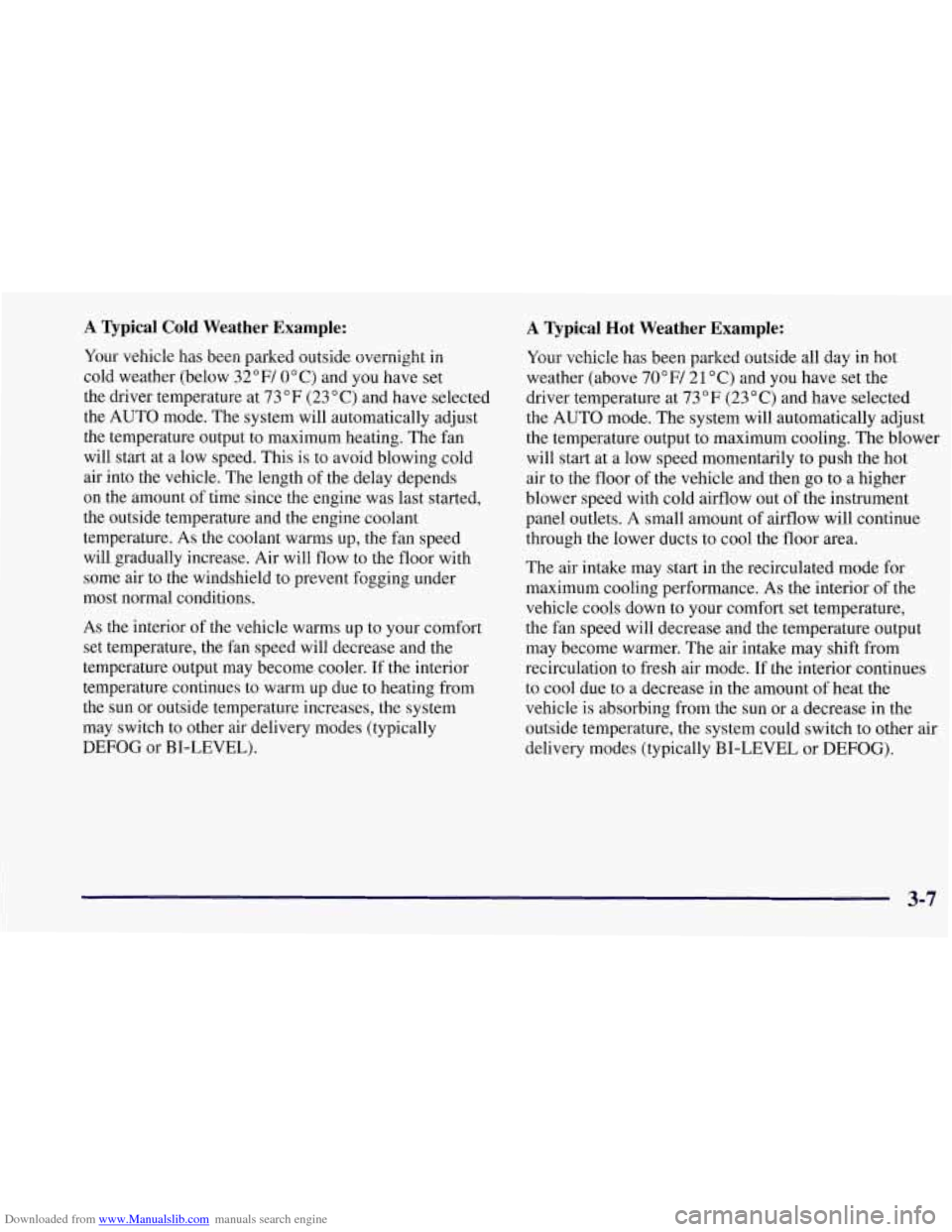
Downloaded from www.Manualslib.com manuals search engine A Typical Cold Weather Example:
Your vehicle has been parked outside ~ver~~ight in
cold weather (below 32 OF/ 0" C) and you have set
the driver temperature at 73 OF (23
"C) and have selected
the AUTO mode. The system will automatically adjust
the temperature output to maximum heating. The fan
will start at a low speed. This
is to avoid blowing cold
air into the vehicle. The length of the delay depends
on the amount of time since the engine was last started,
the outside temperature and the engine coolant
temperature. As the coolant warms up, the fan speed
will gradually increase. Air will flow to the floor with
some air to the windshield to prevent fogging under
most normal conditions.
As the interior
of the vehicle warms up to your comfort
set temperature, the fan speed will decrease and the
temperature output may become cooler. If the interior
temperature continues to warm up due to heating from
the sun or outside temperature increases, the system
may switch to other air delivery modes (typically
DEFOG or BI-LEVEL).
A vpical Hot Weather Example:
Your vehicle has Seen parked outside all day in hot
weather (above
70 OF/ 2 1 O C) and you have set the
driver temperature at
73 "F (23 O C) and have selected
the AUTO mode. The system will automatically adjust
the temperature output to maximum cooling. The blower
will start at a low speed momentarily to push the hot
air to the floor of the vehicle and then
go to a higher
blower speed with cold airflow out of the instrument
panel outlets. A small amount of airflow will continue
through the lower ducts to cool the floor area.
The air intake may start in the recirculated mode for
maximum cooling performance. As the interior of the
vehicle cools down to your comfort set temperature,
the fan speed will decrease and the temperature output
may become warmer. The air intake may shift from
recirculation to fresh air mode.
If the interior continues
to cool due to a decrease in the amount
of heat the
vehicle is absorbing from the sun or a decrease in the
outside temperature, the system could switch to other air
delivery modes (typically BI-LEVEL or DEFOG).
3-7
Page 182 of 356
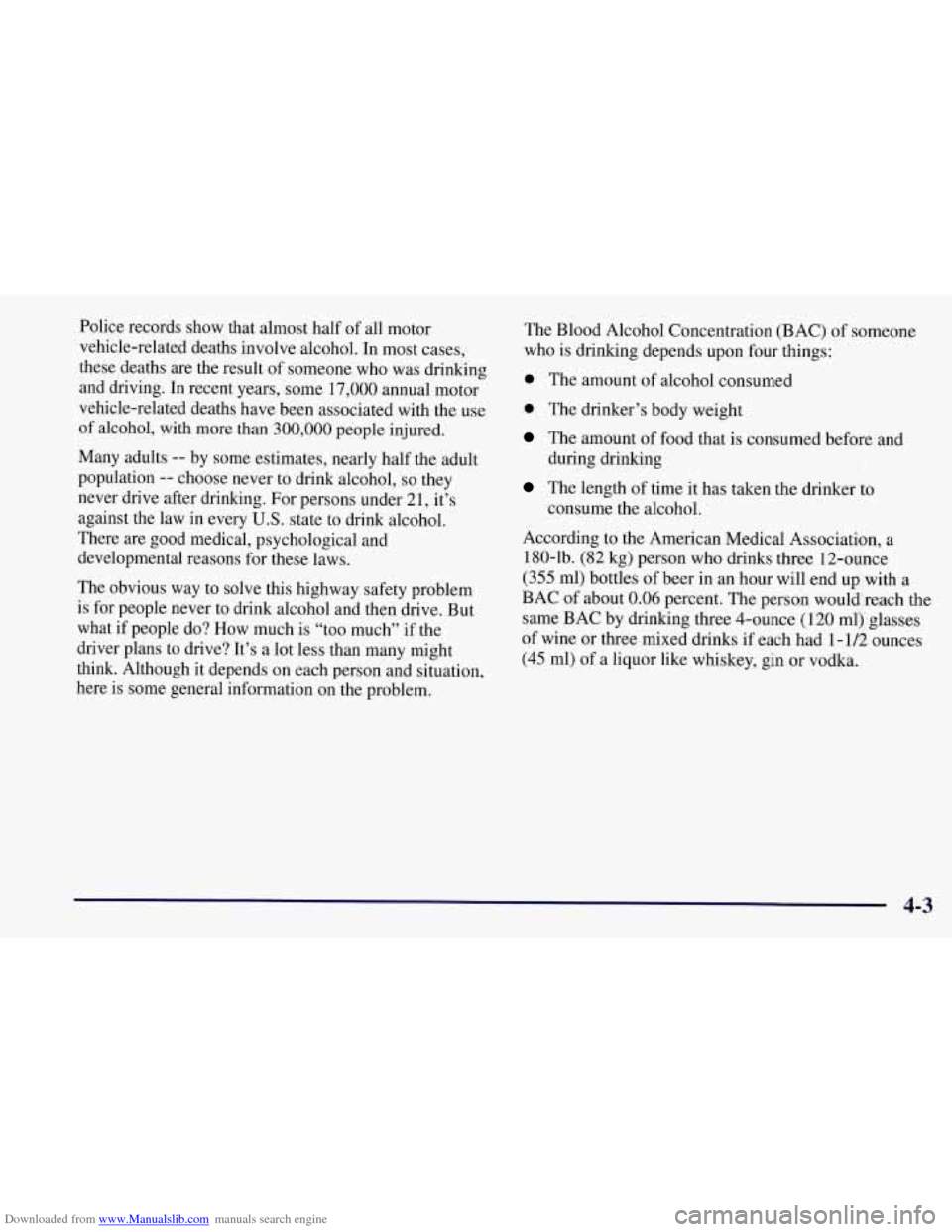
Downloaded from www.Manualslib.com manuals search engine Police records show, that almost half of all motor
vehicle-related deaths involve alcohol. In most cases,
these deaths
are the result of someone who was drinking
and driving. In recent years, some 17,000 annual motor
vehicle-related deaths have been associated with the use
of alcohol, with more than
300,000 people injured.
Many adults
-- by some estimates, nearly half the adult
population
-- choose never to drink alcohol, so they
never drive after drinking. For persons under 21, it’s
against the law
in every U.S. state to drink alcohol.
There are good medical, psychological and
developmental reasons for these laws.
The obvious way to solve this highway safety problem
is for people never to drink alcohol and then drive. But
what
if people do? How much is “too much” if the
driver plans to drive? It’s a lot less than many might
think. Although it depends on each person and situation,
here is some general information on the problem. The Blood Alcohol Concentration (BAC)
of someone
who is drinking depends upon four things:
0 The amount of alcohol consumed
0 The drinker’s body weight
The amount of food that is consumed before and
during drinking
The length of time it has taken the drinker to
consume the alcohol.
According to the American Medical Association, a
180-lb. (82 kg) person who drinks three 12-ounce
(355 ml) bottles of beer in an hour will end up with a
BAC of about
0.06 percent. The person would reach the
same BAC by drinking three 4-ounce
(1 20 ml) glasses
of wine or three mixed drinks if each had 1-1/2 ounces
(45 ml) of a liquor like whiskey, gin
or vodka.
4-3
Page 272 of 356
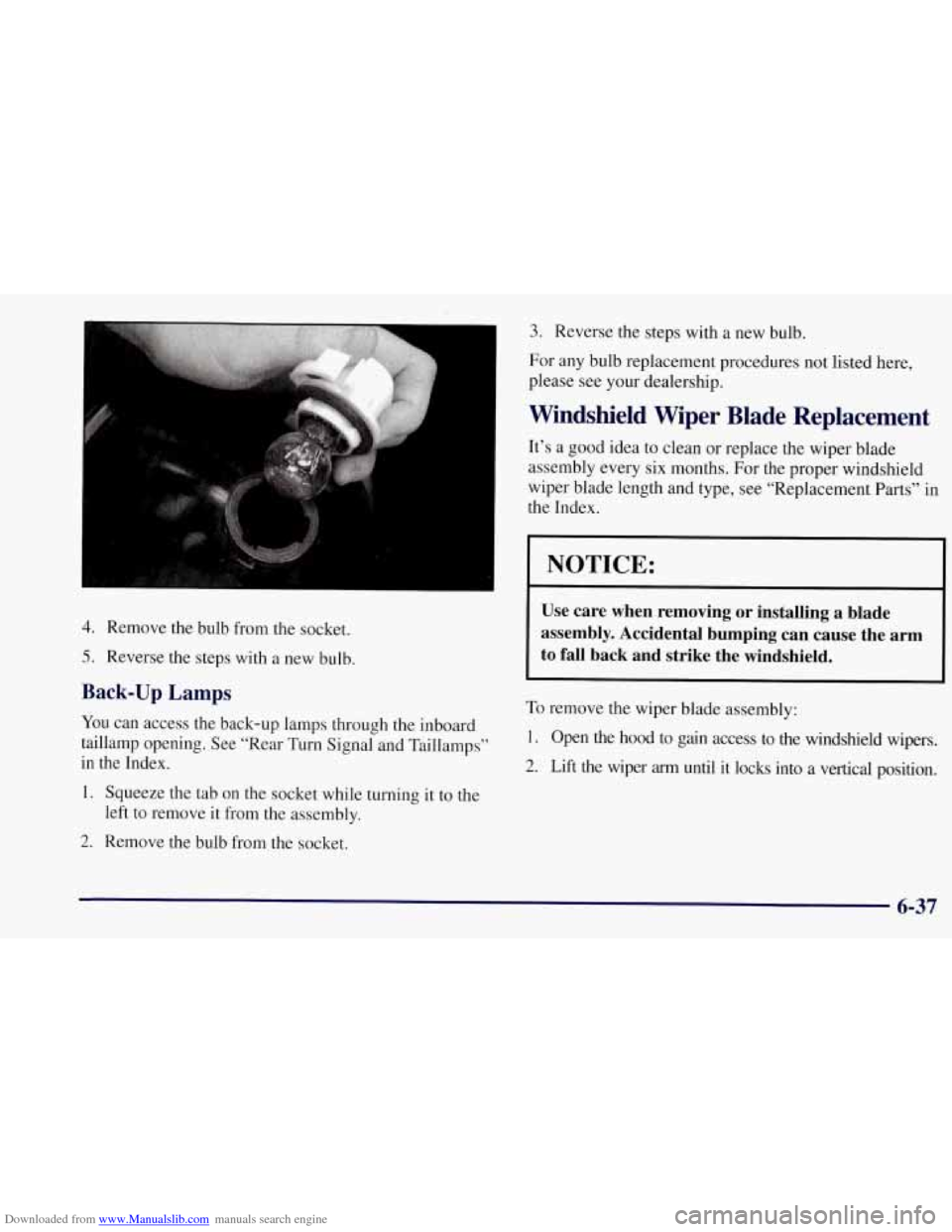
Downloaded from www.Manualslib.com manuals search engine 4. Remove the bulb from the socket.
5. Reverse the steps with a new bulb.
Back-up Lamps
YOU can access the back-up lamps through the inboard
taillamp opening. See “Rear Turn Signal and Taillamps”
in the Index.
1. Squeeze the tab on the socket while turning
it to the
2. Remove the bulb from the socket.
left
to remove it from the assembly.
3. Reverse the steps with a new bulb.
For any bulb replacement procedures not listed here,
please see your dealership.
Windshield Wiper Blade Replacement
It’s a good idea to clean or replace the wiper blade
assembly every six months. For the proper windshield
wiper blade length and type, see “Replacement Parts” in
the Index.
NOTICE:
Use care when removing or installing a blade
assembly. Accidental bumping can cause the
arm
to fall back and strike the windshield.
To remove the wiper blade assembly:
I. Open the hood to gain access to the windshield wipers.
2. Lift the wiper arm until it locks into a vertical position.
6-37
Page 305 of 356
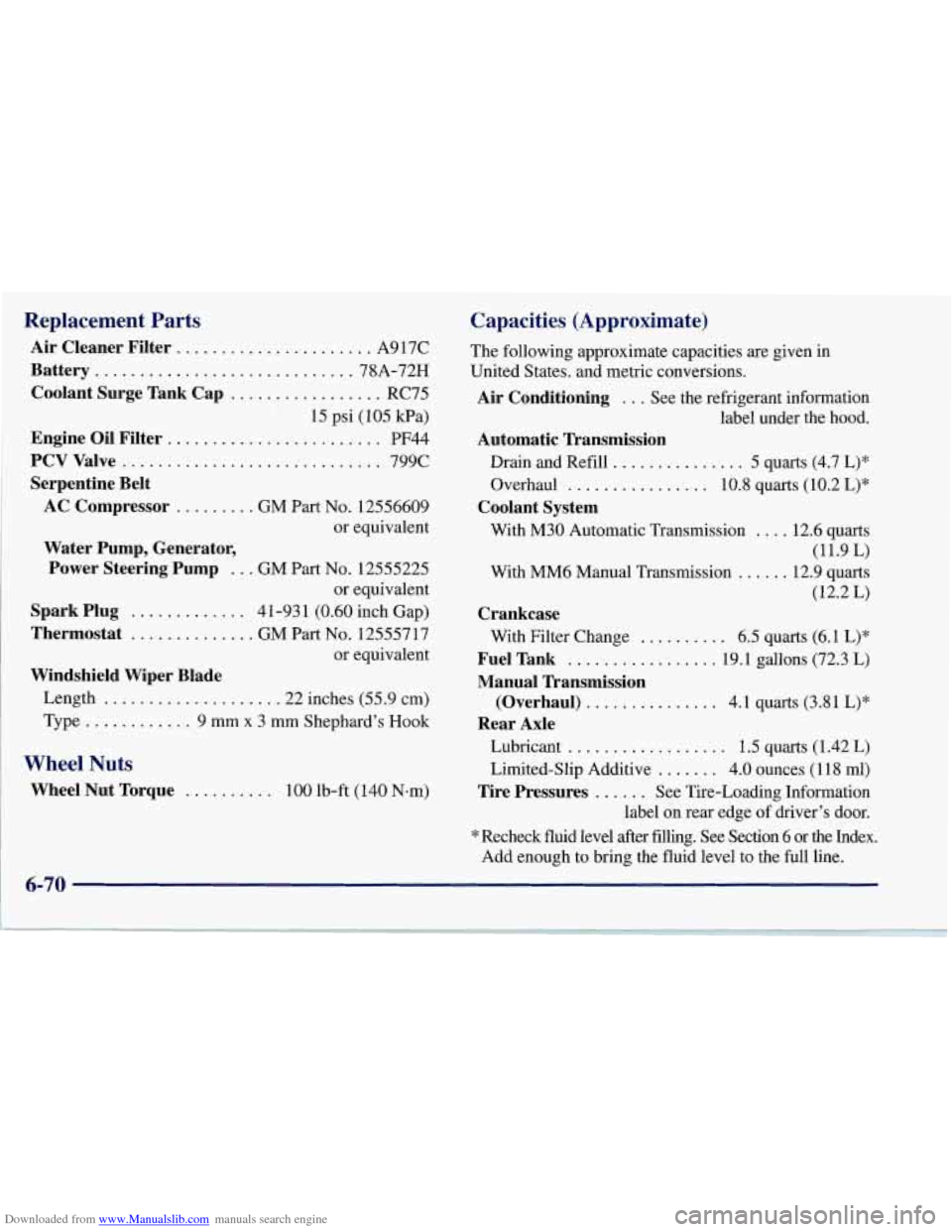
Downloaded from www.Manualslib.com manuals search engine Replacement Parts
Air Cleaner Filter ...................... A917C
Battery ............................. 78A-72H
Coolant Surge Tank Cap ................. RC75
Engine Oil Filter ........................ PF44
15
psi (105
kPa)
PCV Valve ............................. 799C
Serpentine Belt
AC Compressor
......... GM Part No. 12556609
or equivalent
Water Pump, Generator, Power Steering Pump
... GM Part No. 12555225
or equivalent
Thermostat .............. GM Part No. 125557 17
or equivalent
Windshield Wiper Blade Spark Plug
............. 4 1-93 1 (0.60 inch Gap)
Length
................... .22 inches (55.9 cm)
Type
............ 9 mm x 3 mm Shephard’s Hook
Wheel Nuts
Wheel Nut Torque .......... 100 lb-ft (140 Nsm)
Capacities (Approximate)
The following approximate capacities are given in
United States. and metric conversions.
Air Conditioning ... See the refrigerant information
label under the hood.
Automatic Transmission
Drain and Refill ............... 5 quarts (4.7 L)*
Overhaul
................ 10.8 quarts (10.2 L)*
With M30 Automatic Transmission
.... 12.6 quarts
With MM6 Manual Transmission
...... 12.9 quarts
(12.2 L)
With Filter Change
.......... 6.5 quarts (6.1 L)*
Fuel Tank ................. 19.1 gallons (72.3 L)
Coolant System
(11.9 L)
Crankcase
Manual Transmission Rear Axle (Overhaul)
................ 4.1 quarts
(3.81 L)*
Lubricant
.................. 1.5 quarts (1.42 L)
Limited-Slip Additive
....... 4.0 ounces (1 18 ml)
Tire Pressures ...... See Tire-Loading Information
label on rear edge of driver’s door.
*Recheck fluid level after filling. See Section
6 or the Index.
Add enough to bring the fluid level to the full line.
Page 306 of 356
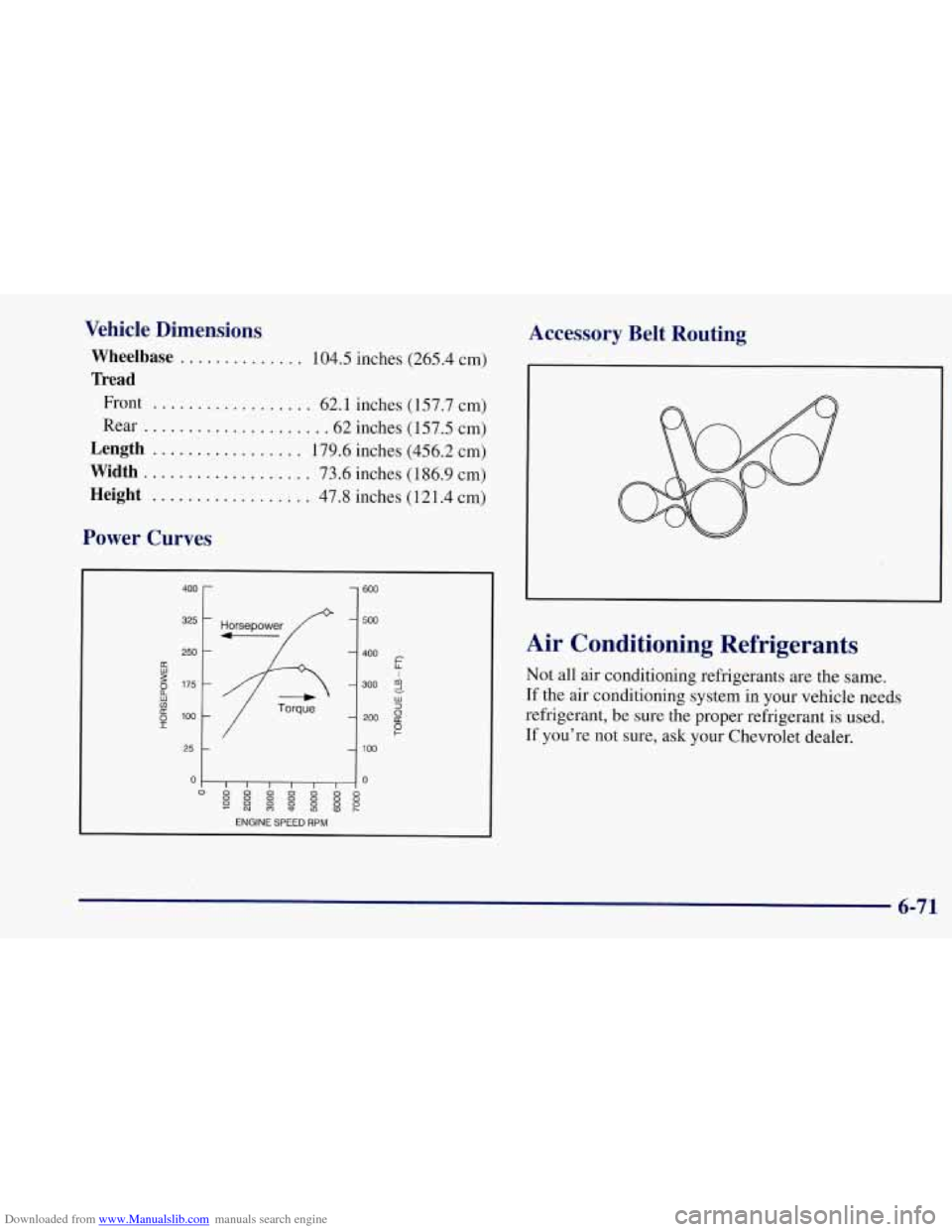
Downloaded from www.Manualslib.com manuals search engine Vehicle Dimensions
Wheelbase .............. 104.5 inches (265.4 cm)
Tread
Front .................. 62.1 inches (157.7 cm)
Rear
.................... .62 inches (1 57.5 cm)
Length ................. 179.6 inches (456.2 cm)
Width ................... 73.6 inches (1 86.9 cm)
Height .................. 47.8 inches (1 21.4 cm)
Power Curves
I 400
325
250
-
a
g ' 175 -
w v) U
I 0 100 -
- Horsepower
Torque
25 t
600
500
400 E I 300 5
UI 3 200 8
P
1 loo
Accessory Belt Routing
Air Conditioning Refrigerants
Not all air conditioning refrigerants are the same.
If the air conditioning system in your vehicle needs
refrigerant, be sure the proper refrigerant is used.
If you're not sure, ask your Chevrolet dealer.
6-71